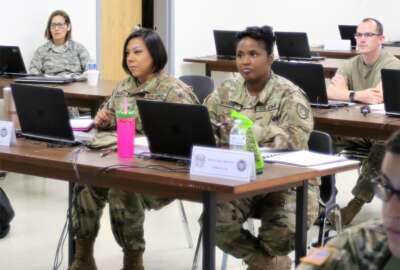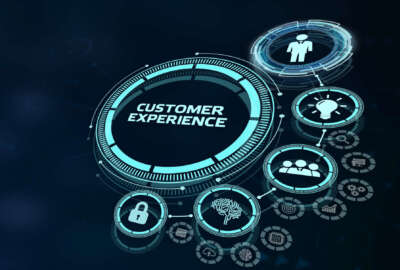Meet the woman behind the latest customer experience drive
Amira Boland was the first OMB head of customer experience, and a driving force to call on all agencies to improve the services they deploy to the public.
You might not think of the Office of Management and Budget as a locus of customer experience. Amira Boland was the first OMB head of customer experience, and a driving force behind the 2021 executive order calling on all agencies to improve their services to the public. Boland joined the Federal Drive with Tom Temin to discuss.
Interview transcript:
Tom Temin: And I guess we should start by saying that you’re actually no longer with the government. You have left for the nonprofit world. Just briefly tell us what you’re up to these days.
Amira Boland: Yeah, absolutely still a public servant at heart. One of the things that I really discovered through my work was the importance of states in delivering federally funded benefits and that was really a gap in my experience. And as we’re working to improve services, I think the more that we’re connecting lessons from the ground up to the federal level, the better we can deliver at the federal level. So, I’m taking some time now working with a nonprofit that provides free public technical assistance teams to states and delivering federally funded benefits.
Tom Temin: Ok, well, let’s go back to the days at OMB, where you were the head of customer experience. What did that mean? What did they tell you were supposed to do there?
Amira Boland: Well, it was one of those great examples where you got to design your own job. I don’t think anyone really had the vision, you know, for what the role would look like. But I was really fortunate in the Trump administration, actually, to get to work for Margaret Weikert, who was the deputy director for management at the time. And in that president’s management agenda of 2018, it really elevated service, a service to the public for the first time, in a more mature way, talking about customer experience and the end-to-end journey of someone actually trying to interact with government. And so, we pitched this idea of someone kind of working full time on that mandate. And being at OMB, not just, you know, most of OMB is organized by agencies. So, staff are aligned to, you know, an agricultural portfolio with the U.S. Department of Agriculture, Forest Service, or something like that. And I was more issue focused, so looking at disaster assistance, which obviously cuts across multiple agencies. So, it was a great way of working horizontally across my organization.
Tom Temin: And you were behind this memo that came out toward the end of the Trump administration on customer experience. And I guess in some ways that was one of the maybe few things that was picked up on in its own way by the Biden administration.
Amira Boland: Yeah, I think this area is really nonpartisan. And obviously it really took, you know, we looked back and all the way to the first Bush administration, there were executive orders on customer service and Clinton and second Bush and, you know, into the Obama administration, obviously with the healthcare.gov response and really bringing technologists into government. So, it had been gaining momentum for several years. And I think that, you know, as you said, we had support across presidential administrations. And then as the Biden administration came in ready to deliver and had, you know, a pretty busy mandate of things they wanted to do, you know, they came in with technology orientation. There were senior advisers for delivery on every agency review team and so we were able to kind of keep moving and pick up speed.
Tom Temin: And you point out something important that a lot of folks often overlook is that the service to the citizen movement, as it was called then, did actually start in the George H.W. Bush administration. What do you think is different now? Is it the enabling technologies have moved things along so far?
Amira Boland: Yeah, one thing I’d like to point out is this change from customer service to customer experience. And this is something that we really built up within the civil service, this conversation of that there’s a difference because people will use them interchangeably, and we’re like, ‘Actually, it’s different, and it’s good that it’s different, and we should know how.’ And that idea is that customer service is really revolution of an issue, right? If you call a call center, or you walk into a field office and you need help with something you’re provided with customer service. Customer experience is thinking about the perspective of the human everything from when they first realized they have a need to figuring out who do I go talk to, what agency do I interact with, what form do I fill out? That whole application process, you know, being notified whether or not you were approved or not approved using that benefit or, like, complying with that service. So, it’s a much kind of higher level, more holistic approach. And I think that, you know, we also really started out with calling this like a technology movement or, you know, civic tech. And it is that, but it’s also more this holistic service design approach that’s different.
Tom Temin: We’re speaking with Amira Boland. She was the lead for customer experience at the Office of Management and Budget, and she is a finalist in this year’s Service to America Medals program. So, in other words, you have to have resolution to have customer experience. But resolution does not equal customer experience.
Amira Boland: The way to sort of think about it is like what is the need or the occasion at which someone comes to interact with you. And we actually use the McDonald’s example. When we were training civil servants, we would say, like, you know, and we had a Presidential Innovation Fellow that had actually worked as the head of digital at McDonald’s, and he said, ‘You know, McDonald’s wants to win that moment that you need some family fun, or you need a fast morning coffee, or you need a quick lunch. Like, those are three occasions. That we want to win.’ And so, we were actually having civil servants think of what is the moment that you want to win? Is it, you know, someone is starting a new business and they need a loan? Is it that a farmer is looking to expand their like prop rotation strategy? You want to win that right? You want them to come to the farm services agency and get the technical assistance that you can provide. So, I think that was a sort of shift in mindset of that you have a product or an offering. You know, the number of times I had an agency tell me, ‘Well, I don’t deliver a service because they just thought of services as benefits.’ And we were saying to OSHA, ‘No, a small business being audited or having a visit complying with workplace safety requirements is you providing a service and what does that look like? And what is the experience of your customer that you’re interacting with?’
Tom Temin: Yeah, so part of the challenge, then sounds like pushing this idea down into the bureaucracy so that people could think differently about what they were doing. A memo does only so far. What did you do to make sure that the memo actually got deep?
Amira Boland: We often joke that a memo could fall in the forest, and no one would know. So, you know, demos, not memos, or, as we like to say, you know, ‘demos and memos.’ You got to do both. You got to have the mandate, and then you got to carry it out. So, we would really try and take. We would, you know, eat our own dog food, or whatever the expression is, where not only would we create the mandate, we would get input into the creation of that mandate. So, we actually had design sessions with federal agencies as we designed the federal customer experience measures. And then, you know, you can’t ask someone to do something that they’ve never done before, right? And so, my background is actually in behavioral science and I’m behavioral economist. We took, you know, that approach of how do we set the mandate and then fast follow with resources, support, training, working groups, cohorts, and really try to bring people along in a way that they felt supported, which is not always true when OMB drops a memo.
Tom Temin: By the way, I’ve heard behavioral economics described as being coercive, but the person coerced doesn’t know they’re being coerced.
Amira Boland: No, not at not at all because, you know, particularly in the Obama administration, actually joined the White House social and behavioral sciences team. That’s what brought me to federal service. And I remember that there was some talk of, you know, Obama social engineers. We were always saying, like, we are not inventing new objectives. The objectives we are trying to deliver on are policy decisions that have been made by Congress that have been made by administrations and that we are trying to more effectively deliver on that. If we have passed a policy in which we believe that a certain people within a certain eligibility threshold, should be eligible for a benefit. If they are not uptaking that benefit, then we’re not having successes, you know, that we set out. And so, that’s been really the focus of our work, is like, how do we better deliver on an objective that elected representatives have put forth.
Tom Temin: And getting back to the idea of getting agencies to think about occasions they wanted to win. Did any stand out in your mind in particular?
Amira Boland: So many. I mean, I remember one day going into a meeting with Customs and Border Patrol and it was my first meeting, and everybody was in a uniform and had a gun and I was, you know, here at this fresh-faced OMB or to talk about customer experience. And I remember going in thinking, like, I don’t know how this is gonna go. But it was actually a really incredible moment and I started by, you know, very much, adopting a human-centered design approach. I asked a ton of questions. I asked about the days that they felt most committed to service and felt like they were living in alignment with the mission that they felt called to serve. And I think very quickly we’ve gotten to a conversation about how someone entering at the border is entering the United States and what does that mean and what should that look like? So that was one meeting that really stuck out to me, you know, all the way to I really, you know, found my passion in the zero to five work that we’ve been doing around, how do we better support, in particular, like all mothers in America that are having a child. But, you know, 42% of children in this country are born on Medicaid. And so, how do we give them the healthiest start? And there’s just so much evidence now to suggest that those early years completely impact the trajectory of people’s lives.
Tom Temin: All right? And getting back to the fact that you have left the government for the nonprofit sector related to governmental services, would you consider coming back to federal service?
Amira Boland: Oh, absolutely. I think this is, you know, part of my call to my colleagues and many others, particularly at OMB, is that we should never be trapped in an ivory tower. I see a ton of folks and it’s great. We need people that have experience and have seen many things and can be at OMB for 20-plus years or at federal agencies for 20-plus years. But I really think that what we’re seeing now is that people rotating between and getting experience at agencies with community-based organizations with private sector and then bringing that back into government is the way that we should be acting. And so, I’m hoping to model that also for my team.
Copyright © 2025 Federal News Network. All rights reserved. This website is not intended for users located within the European Economic Area.
Tom Temin is host of the Federal Drive and has been providing insight on federal technology and management issues for more than 30 years.
Follow @tteminWFED






